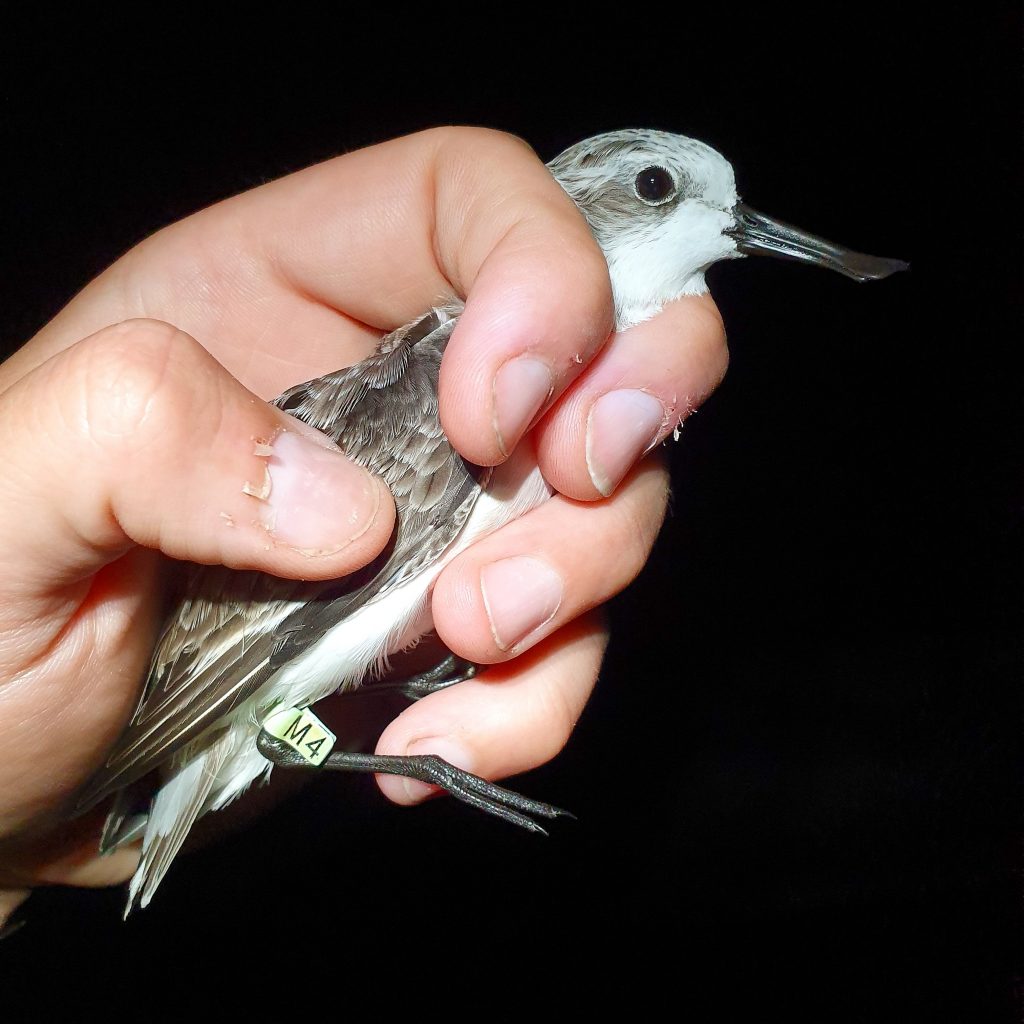From almost the beginning of our now over 60-year history, members of the Wash Wader Ringing Group have travelled around the world to help others with wader-catching projects. Part of this work at present involves helping with work on the critically-endangered Spoon-billed Sandpiper (SBS; https://www.saving-spoon-billed-sandpiper.com/). This autumn, group members were again part of a team led by Professor Chang Quin of Nanjing Normal University, working in Jiangsu, China. The aims of this year’s autumn passage work were to catch and mark SBS, satellite tag a small number, scan flocks of SBS to work out the proportion of marked to unmarked birds to add to our estimate of the numbers of birds using the area (https://www.waderstudygroup.org/article/12026/; https://www.waderstudygroup.org/article/12091/) and to mark and measure a range of other species.

We chose to visit at the end of September, when we had high tides and dark nights (ideal for mist netting) and the birds were at the end of moult, meaning that we could glue mount satellite tags with a reasonable expectation of them staying on for the next couple of months, or so. The satellite tags give us vital information about where these very rare birds winter and have already ‘discovered’ new wintering sites – including a first record of an SBS in Indonesia (https://www.waderstudygroup.org/article/12117/).
The UK participants met up at Heathrow and braved the 11.5 hour flight to Shanghai, followed by a three-hour drive to Rudong and our familiar hotel – a place where they don’t seem to mind if we dry our cannon net in the corridor outside our rooms. It was great to meet up with the Chinese team and volunteers from other parts of the world – new friends and old. The next couple of days were a mixture of scanning work and trying to find out where the SBS were roosting this year. The roost sites vary greatly between years depending what is available to the birds on this coastline which has seen much change in the last few years as a result of very large land claims (now halted). We found most of the small birds on some rice paddies (with no rice) at Tiaozini, with larger birds on an area of dumped sediment in a fish pond area (also at Tiaozini) and on an island in a fish pond area at Fengli.
As we had what looked like good options for mist-netting effectively, we planned to mist net at night and scan during the day. Our approach paid off, but at the expense of sleep….. We mist-netted for six nights (we got a night off when a typhoon passed nearby) and caught a total of nearly 1,800 birds – including five SBS. We were able to satellite-tag four of the SBS, the fifth already carried a flag and we know that it breeds at Meina Pylgno in Russia, passes through Jiangsu and winters in Leizhou, Guangdong, China. In addition, we were able to deploy transmitters on several Grey Plover, both Eurasian and Far Eastern Curlew and one Nordmann’s Greenshank. We also used engraved leg flags on a few species – previously we have just used plain leg flags on all but the SBS, so this will also add to knowledge of their movements.

With so many birds being caught mist-netting, we didn’t’ try trapping, whoosh-netting and cannon-netting until the end of the trip, when we set to try to catch SBS on one site and Nordmann’s Greenshank on another. Unfortunately, the tide did not cover the mudflats and so we saw fewer birds than expected and failed to catch – a shame, but we had still had an enormously successful trip. After sorting, cleaning (as much as possible) and storing or packing our gear, our last night saw our traditional team dinner accompanied by Baijiu (aka Chinese Vodka) and whisky and a talk about SBS research and the results of our work in Jiangsu. Fortunately, we didn’t have an early start the next day, as we just needed to get to Shanghai for a flight the next morning. It was just as well that we weren’t heading straight to the airport as we met a traffic jam which makes the M25 look like the motorway it is supposed to be – at one point it took us 1.5 hrs to move 1 km. Still, we reached the hotel and got out in time for dinner. The flight home the next day was preceded by the usual checking of our luggage, as we all have batteries for various uses – the officials checking were not impressed by the state of some of our clothes after all that mist-netting.
Another successful trip – now we wait to hear where the birds with transmitters go to add to our knowledge of them.
Trip totals
| Kentish Plover | 559 |
| Dunlin | 509 |
| Terek Sandpiper | 214 |
| Red-necked Stint | 112 |
| Greater Sand Plover | 93 |
| Lesser Sand Plover | 90 |
| Grey Plover | 42 |
| Sanderling | 31 |
| Broad-billed Sandpiper | 20 |
| Marsh Sandpiper | 15 |
| Eurasian Curlew | 11 |
| Long-toed Stint | 10 |
| Whimbrel | 10 |
| Ruddy Turnstone | 9 |
| Far Eastern Curlew | 8 |
| Bar-tailed Godwit | 8 |
| Great Knot | 8 |
| Grey-tailed Tattler | 7 |
| Spoon-billed Sandpiper | 5 |
| Little Ringed Plover | 4 |
| Common Redshank | 3 |
| Common Sandpiper | 2 |
| Pied Avocet | 1 |
| Temminck’s Stint | 1 |
| Red-necked Phalorope | 1 |
| Black-tailed Godwit | 1 |
| Wood Sandpiper | 1 |
| Nordmann’s Greenshank | 1 |
| Green Sandpiper | 1 |
| Pacific Golden Plover | 1 |
| Grand Total | 1,778 |
Header photo: Spoonie Team 2019, by Kane Brides

